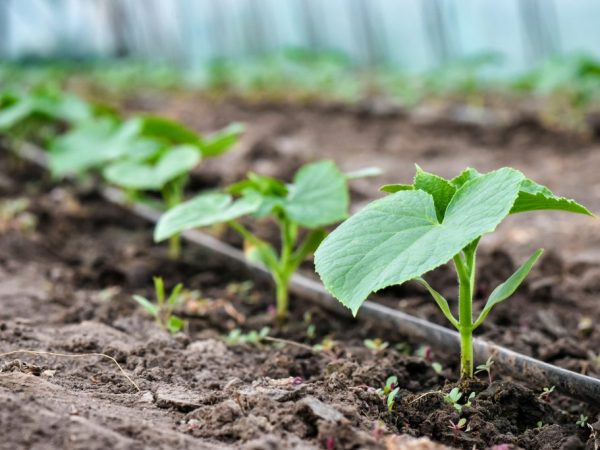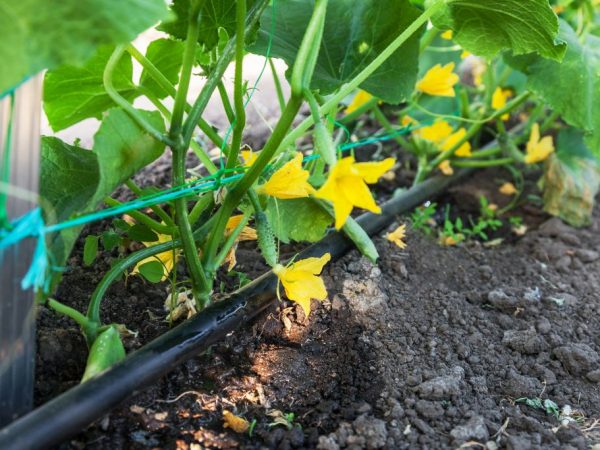Drip irrigation of cucumbers
Cucumbers are tropical plants and therefore prefer moist air and soil. Drip irrigation of cucumbers will allow you to achieve maximum yield and avoid many problems when growing in a greenhouse.
- Method characteristic
- The benefits of drip irrigation
- Varieties of homemade drip irrigation
- Features of watering in the greenhouse
- Single stream irrigation
- Multi-stream irrigation
- Irrigation time and duration
- Methods for supplying water for drip irrigation in a greenhouse
- Gravity
- Highway
- Pumping station
- The main rules for watering in a greenhouse
- Conclusion

Drip irrigation of cucumbers
Method characteristic
Drip irrigation of cucumbers in the greenhouse is the best way to maintain the moisture in the soil and indoor air. In essence, this is the delivery of water, fertilizers and fungicides to the root zone of the cucumber through the laid thin-walled belts, into which the droppers are built. Sometimes they are purchased ready-made from specialized stores, but more often they are made independently.
The flow rate, the diameter of the tube, the distance between the droppers are chosen by each grower individually. It depends on several factors:
- landing schemes;
- landing area;
- water connection method.
The benefits of drip irrigation
Drip irrigation of cucumbers in the greenhouse makes it possible to provide the root system with water and nutrients better than with any other method of irrigation.
- The percentage of moisture utilization is more than 95%. For comparison, at sprinkling 65%.
- Soluble fertilizers reach the roots along with water. This helps the nutrients to be absorbed completely.
- When watering cucumbers with a drip method, the risk of occurrence and transfer of diseases from the leaf is reduced. They stay dry.
- Water consumption for evaporation is significantly reduced. This reduces the cost of the growing process, the cost of production, labor costs for caring for cucumbers.
For cucumbers, drip irrigation is necessary, since it allows you to process plants, spray, harvest, regardless of the season. The areas of soil between the rows are always kept dry.
Varieties of homemade drip irrigation
In order to save money, some elements of drip irrigation can be made by hand. Instead of purchased pipelines, use the hoses available on the personal plot. After a certain distance, make holes in them. The water should drip. This method is suitable for small greenhouses because it is not possible at first to provide even watering at the beginning and end of the bed.
Some growers use DIY drip systems. Simply by using dark plastic bottles of various capacities. They should be filled with a weak nutrient solution, placed along the beds with plants at small intervals. Install plastic bottles in the ground with the neck down without a lid. The earthen plug, which is formed in this case, will prevent the liquid from flowing out quickly. The soil will get wet gradually, constantly and evenly. Due to the natural heat in the greenhouse room or under the film, the solution in the plastic bottle will be warm. And cucumbers are very fond of this.
Features of watering in the greenhouse
When growing cucumbers, it is required to follow the rules of care at different periods of growth. Do not overmoisten or overdry the soil.
After planting the seedlings, drip lines are laid out. If the planting was single-row, then the drip line is located at a distance of 10-15 cm from the stem. To water with a two-row planting, the drip tape can be placed in two ways, depending on the desired effect and the size of the greenhouse.
Single-stream irrigation
This method is suitable for a small greenhouse. Here one tube is placed between the rows. Droppers are taken with a large flow of water.
Multi-stream irrigation

Tubing should be laid along each row of plants
In the second version, tubes are laid along each row. Drippers are needed at a lower flow rate. Depending on the distance between the plants, the gap between the droppers on the tube is selected.
Irrigation time and duration
It is difficult to answer the question of how long watering takes without knowing the characteristics of the drip tape used and the pressure in the system. Moisture-charging watering should be carried out immediately after planting plants in the ground. A continuous wet path should form along the row. The frequency depends on weather conditions and soil composition. Humidity in the root zone of a cucumber should be at least 70-75% HB.
Water should be done carefully at low temperatures. The likelihood of the appearance of various diseases is high.
The nutrient solution is fed in this way in the middle of the process. First, you need to moisten the soil, and after top dressing, rinse the drip irrigation system.
Methods for supplying water for drip irrigation in a greenhouse
This process can be done in several ways:
- gravity water supply;
- main water supply
- water supply from the pumping station;.
Gravity
To supply water by gravity, you need a container with water, with a drip system attached to it. This container must be installed at a certain height so that the water can drain off by gravity.
Highway
To supply water from the mains, the hoses are connected to the central water supply. It is necessary to put a pressure regulator so that the pressure does not exceed 1 atm. Cold water comes from the water supply system, and this must be taken into account, because cucumbers are thermophilic plants.
Pumping station
The pumping station with the connected system holds the pressure well. Best installed near a water source (cisterns, river, pool, etc.). This requires a suction hose with a non-return valve and a filter. The pump will turn on as soon as the tap opens. Water will begin to flow into the irrigation system.
From time to time, the pump will turn off due to the slow dripping of water from the hoses. It can be installed in any accessible room so that the work takes place in automatic mode. You don't have to be around all the time.
The main rules for watering in a greenhouse
For cucumbers to be healthy throughout the growth period, the following rules should be followed:
- regularity;
- the water temperature should be equal to the temperature of the earth;
- defend water;
- do not pour at the very root;
- prevent diseases of the leaf system;
On hot days (above 25 ° C), it is necessary to ventilate the greenhouse. This will allow the cucumbers to get enough oxygen and no excess moisture.
If the heat persists for several days in a row, pour the cucumber leaves from a watering can. This method of sprinkling will help humidify the air and reduce the temperature in the greenhouse. But this must be approached with caution. It is better not to do it if disinfection measures were taken shortly before. Leaf burns may occur. You can simply shade the windows to avoid overheating the room.
Drizzle with warm water so that the upper root hairs are not damaged. They are not restored. The loss of at least part of the root system will entail rotting of the entire root and death of the plant.
Conclusion
It is not difficult to make a drip irrigation system, knowing its basic principles.It helps to automate the irrigation process, increases the yield of cucumber and makes it easier to work in the greenhouse.


